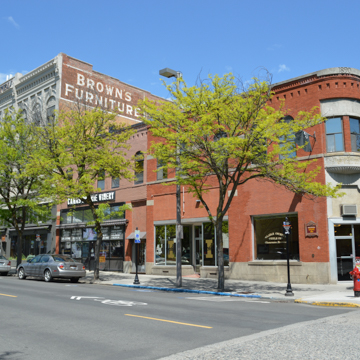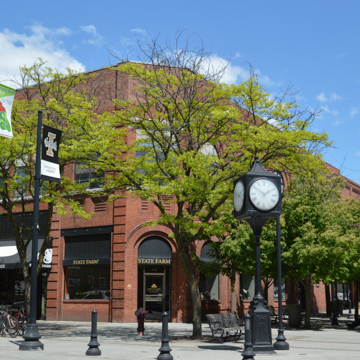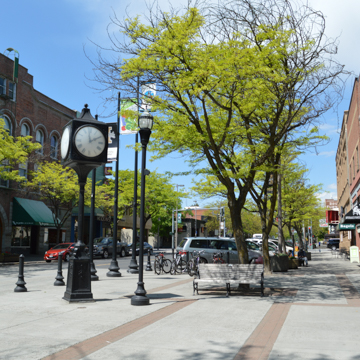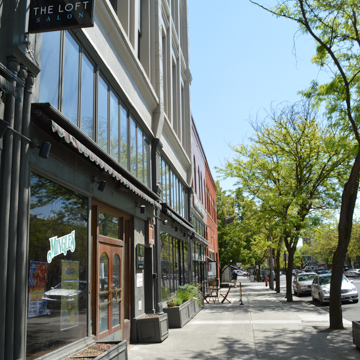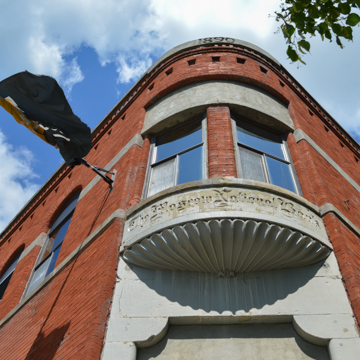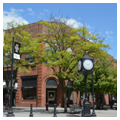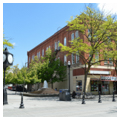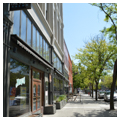According to historians who traveled throughout North Idaho at the turn of the twentieth century to interpret the early histories and future viability of the region’s towns, Moscow was a community where the early “pioneers got it right.” In 1903, visiting historians observed a thriving town in the center of a rich agricultural valley, where commercial development significantly outpaced resident population growth. They noted that, here, in contrast to other pioneer settlements, railroad companies accepted early settlers’ geographic choice for the town center rather than forcing the town to move the commercial districts to accommodate railroad interests. Downtown Moscow has persisted as the symbolic heart of the community and center of public life. Its late-nineteenth- and early-twentieth-century buildings have adapted to changing needs over time and currently serve entertainment and housing needs of a university city.
Multiple conditions favored early Moscow’s capacity to achieve stability and prosperity as a business center during its formative years. The region’s geography was naturally accommodating of human habitation. For hundreds of years “Tatkinmah,” the “valley of the spotted deer” in which Moscow is located, served as a seasonal meeting grounds for tribal peoples including the Nez Perce, Coeur d’Alene, and Palouse, who frequented the area to harvest camas roots, trade, and race horses. Early settlers benefitted from ease of access to the region afforded by the Nez Perce Trail, which climbed two thousand feet from the tribe’s winter home in the Snake River Valley. In 1871, the first wave of homesteaders ascended the trail and claimed land in what they called “Paradise Valley,” a landscape of rich soil, bucolic grassy hills, and gently flowing streams. As farm families in pursuit of a permanent home, they brought early stability to the area and a need for a commercial marketplace. Moscow’s formative years also benefitted from the foresight and generosity of four homesteaders and businessmen (Almon Lieuallen, James Deakin, Henry McGregor, and John Russell), who each donated 30 acres of their intersecting claims to establish the initial townsite and commercial center. From the start, they established a climate for community stability by cultivating commercial enterprises along Main Street. Their motivations differed from those of fortunes seekers throughout the west, who temporarily populated, and exploited, early western settlements and then moved on.
Given its central location within a highly productive agricultural landscape, downtown Moscow quickly expanded from its humble beginnings into a booming regional marketplace for outlying communities and farmsteads. In 1885, the railroad arrived downtown, assuring Moscow’s role as a regional shipping point. Equally vital to the commercial district’s economic well-being, was the territorial legislature’s 1888 decision to locate the University of Idaho in Moscow. The combined economic stimuli afforded by agriculture, railroad linkage, and education produced downtown Moscow’s most significant period of commercial development. All downtown buildings constructed between 1888 and 1893 were either retail establishments or banks; over one-third of buildings designated as “contributing” to Moscow’s National Historic Downtown District were built in this period. Their developers, which included William McConnell, Robert H. Barton, and Michael Shields, were among Moscow’s most influential local businessmen. In architectural stature and purpose, these buildings remain unsurpassed by later periods of downtown development.
In 1891, William McConnell and his partner, James McGuire, erected the McConnell-McGuire Building, a three-story department store on the southeast corner of First and Main Streets. The physical heart of downtown during this period, however, developed at the intersection of Fourth and Main Streets, where a prominent commercial building was constructed at each corner between 1889 and 1891. All of the structures were built of brick, as required by an 1891 city ordinance regulating fire safety. The 1891 Skattaboe Block, originally constructed on the southwest corner of the intersection in the Richardsonian Romanesque style, was modified at the street level in the 1980s. The Hotel Moscow, a replacement building following a catastrophic fire in 1890, was also designed in the Richardsonian Romanesque style. Across the street on the northeast corner, Leonidas McCartor erected two mixed-use buildings in the Romanesque Revival style in 1891 and 1896, respectively. The 1891 building initially served as Farmer’s Bank before becoming Moscow’s City Hall in 1900, and it served in that capacity until the mid-twentieth century. Use of the Italianate style for downtown buildings was also relatively common as in the Shields Building on the intersection’s southeast corner. Michael Shields developed the Shields Building North as Moscow’s first three-story brick building with an elevator in 1889. The building has since lost some of its original ornamentation and has been modified at the street level.
Mirroring national economic trends, downtown development and construction activity paused during the economic panic of 1893. The national recession led to a slowdown in new construction and the upper floors of several department stores were converted from retail space to offices and apartments between 1893 and 1900. Main Street’s growth resumed in tandem with the country’s economic recovery. Twenty percent of the downtown district’s current inventory of buildings was built between 1900 and World War I. The majority are one- and two-part, block-style commercial buildings. They are smaller in scale and simpler in their detailing than buildings associated with downtown’s peak period. The Kenworthy Theater, a vaudeville and motion picture venue, is a notable exception. Between World War I and World War II, downtown continued to infill with brick and concrete block buildings designed in period-appropriate Art Deco and Spanish Mission styles. Both downtown movie theaters exhibit Art Deco influences and remain popular destinations for cultural entertainment and community events.
Typical of downtowns throughout the country during the post–World War II period, retail businesses and buildings along Moscow’s Main Street suffered from the erosive effects of highway traffic and shopping mall construction. A downtown revitalization initiative in 1980, featuring highway rerouting, streetscape improvements, and construction of a public plaza at the downtown’s core intersection at 4th and Main, helped to re-establish Main Street as a center for public life. The historic integrity of even the most prominent downtown buildings has been compromised, and many bear the marks of storefront modifications intended to forestall retail decline. Collectively, however, they provide a palimpsest of inherited culture and visitors to Moscow’s Main Street need only look up from street level at the brick buildings to connect with late-nineteenth-century community builders who had envisioned downtown Moscow as a bustling regional marketplace.
References
Attebury, J. Building Idaho: An Architectural History.Moscow: University of Idaho Press, 1991.
David, H. “Moscow at the Turn of the Century.” Moscow, ID: Local History Paper #6, Latah County Historical Society, 1979.
Hibbard, Don, “McConnell-McGuire Building,” Latah County, Idaho. National Register of Historic Places Registration Form, 1977. National Park Service, U.S. Department of Interior, Washington DC.
Julin, Suzanne, “Moscow Downtown Historic District,” Latah County, Idaho. National Register of Historic Places Registration Form, 2005. National Park Service, U.S. Department of Interior, Washington DC.
Julin, Suzanne, and D. Krae, “Kenworthy Theater,” Latah County, Idaho. National Register of Historic Places Registration Form, 2001. National Park Service, U.S. Department of Interior, Washington DC.
Monroe, J. Moscow: Living and Learning on the Palouse, Charleston, SC: Making of America Series, Arcadia Publishing, 2003.
Otness, L. A Great Good Country: A Guide to Historic Moscow and Latah County, Idaho. Moscow, ID: Local History Paper # 8, Latah County Historical Society, 1983.
Western Historical Publishing Company. An Illustrated History of North Idaho: embracing Nez Perce, Idaho, Latah, Kootenai and Shoshone Counties, State of Idaho. Spokane, WA: Western Historical Publishing Company, 1903.
Wright, Patricia, “Hotel Moscow,” Latah County, Idaho. National Register of Historic Places Registration Form, 1978. National Park Service, U.S. Department of Interior, Washington DC.










